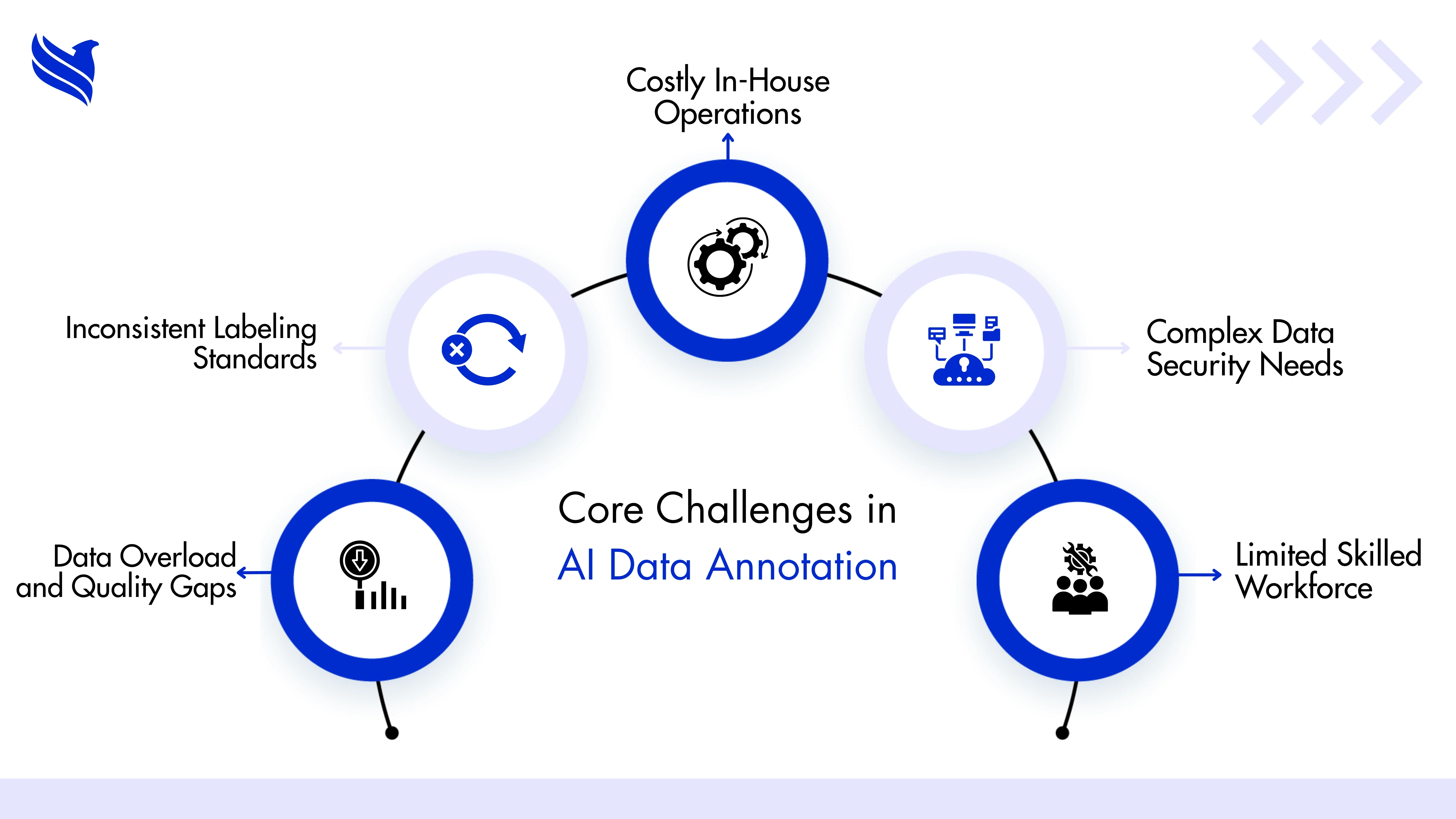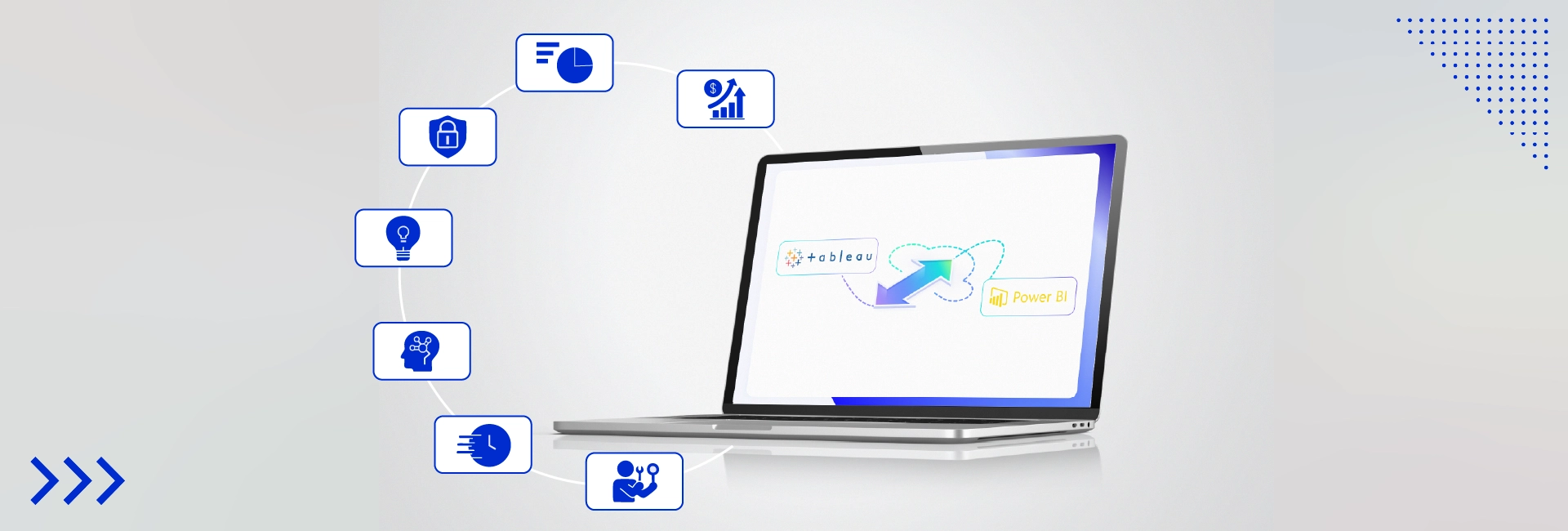Quick summary - This blog analyzes the leading companies providing text and video annotation services for AI projects, outlining key operational challenges, advantages of outsourcing, and the shifting landscape where human expertise and intelligent automation combine to redefine the future of data annotation and AI readiness.
Get an in-depth look at global leaders offering text and video annotation for AI, exploring challenges, benefits, and future industry directions.
How does a self-driving car decide when to stop? Or how does an intelligent chatbot sense the difference between a joke and a complaint?
Behind every “smart” action lies a surprisingly human story, people labeling, tagging, and sorting fragments of data so machines can make sense of the world. This invisible labor, called data annotation, fuels the entire AI ecosystem. It turns raw information into structured lessons that algorithms can learn from. Whether it’s marking text for intent, or identifying objects in video frames, annotation shapes how machines see and interpret reality.
Yet, as data volumes explode, doing this in-house has become impractical. That’s why many organizations now rely on AI annotation service providers, companies specializing in text annotation services and video annotation services for large-scale machine learning. They combine human intelligence with precise workflows to train AI systems faster, cheaper, and more accurately.
In this blog, we’ll explore why annotation is so vital, who the key players are, what to consider when choosing an outsourcing partner, and how this industry is quietly defining the future of AI.
Why annotation is the unsung hero of AI
Every algorithm starts its journey with confusion. A computer doesn’t know what a “car” or “cat” or “sarcastic tone” means. It only sees patterns, shapes, numbers, and sound waves. Annotation gives those patterns meaning. A text label tells the system: this is anger, this is approval, and this is a pedestrian crossing the street.
Without that labeled foundation, even the most advanced neural network would wander aimlessly. Text annotation for AI helps models understand intent, grammar, and emotion; while video annotation for AI teaches systems how to interpret motion, recognize faces, or track activities frame by frame.
The quality of this groundwork determines everything that follows. A poorly annotated dataset can lead to biased or unreliable results. On the other hand, meticulous annotation brings clarity, fairness, and consistency, the cornerstones of trustworthy artificial intelligence.
Why companies struggle with data labeling
When AI projects scale, annotation becomes one of the hardest challenges to manage. Many organizations underestimate just how much labeled data is required. Training a simple visual model can mean processing millions of video frames. Text annotation can take weeks of linguistic analysis for a single chatbot domain.
Recruiting, training, and supervising annotators in-house often leads to inconsistent results. Time zones, data security, and quality control add more layers of complexity. Then comes the emotional side; repetitive labeling can lead to fatigue, and without structured feedback, accuracy slips.
That’s where outsourcing video annotation and text labeling steps in. Specialized providers bring structured teams, quality checks, and scalable infrastructure, turning what was once a bottleneck into a streamlined pipeline.
Leading names in the annotation industry
Across the world, a small group of companies have turned annotation into a craft. They’re the bridge between messy raw data and usable machine learning insights.
1. FBSPL (Fusion Business Solutions P Limited)
FBSPL has become a trusted name in AI annotation services, particularly in industries where precision and confidentiality matter most, insurance, finance, and healthcare. Their teams handle both text annotation and video annotation services, backed by strong workflow controls and transparent quality systems. What makes them different is their balance of technology and people; every project is monitored, measured, and improved continuously. For companies that need accuracy at scale, FBSPL offers the reliability of enterprise outsourcing with the care of a boutique partner.
2. Scale AI
Headquartered in San Francisco, Scale AI works with some of the biggest tech firms and automotive leaders. Their video annotation & labeling services help train autonomous vehicles to detect lanes, pedestrians, and traffic signals in real time. Scale’s hybrid model, part automation, part human verification, keeps precision high even on massive datasets.
3. iMerit
This Indian brand brings a strong ethical foundation to annotation. Their teams handle complex AI annotation services across medical imaging, agriculture, and geospatial intelligence. iMerit’s reputation rests on accuracy and workforce empowerment, giving data labeling a human dignity often missing from the field.
4. Cogito Tech
Cogito Tech focuses on emotional intelligence and behavioral data. They’re known for fine-tuned text annotation services for sentiment, chat, and speech recognition projects.
5. CloudFactory
They combine purpose with productivity. Its distributed teams support video annotation for AI at scale while maintaining strict data security. The company’s model emphasizes fair pay and skill growth, a reflection of how responsible outsourcing can create social value.
LXT, Lionbridge AI (now TELUS International), and Clickworker also rank among the reliable global players offering end-to-end data annotation services. Each brings unique expertise: LXT in multilingual text datasets, Lionbridge in enterprise AI translation, and Clickworker in microtask-based labeling.
What connects them all is an understanding that annotation isn’t mechanical. It’s interpretive work, half art, half logic, requiring trained judgment, not just clicking boxes.
How to choose the right AI annotation partner
Selecting an annotation provider isn’t about finding the lowest quote; it’s about choosing someone who understands your data like an insider.
Start with experience in your industry. A partner who has worked with healthcare data knows the sensitivity of medical imagery; one in autonomous driving understands the importance of millisecond-level accuracy.
Ask for quality assurance protocols, multi-layer review systems, audit trails, and bias checks separate serious providers from generic ones.
Data security is non-negotiable. Look for certifications like ISO/IEC 27001 or SOC 2. In regulated sectors, HIPAA or GDPR compliance is essential.
Also, consider communication and scalability. AI projects evolve; today’s 10,000-frame dataset can turn into 10 million frames overnight. Choose a team that can scale without losing quality.
And finally, trust intuition. The best partnerships feel less like outsourcing and more like collaboration. The right provider will ask the kind of questions that show they actually care about your model’s accuracy, not just your invoice total.
The future of data annotation
The conversation around annotation is changing. In the early days, it was seen as repetitive labor; now, it’s becoming a blend of human insight and intelligent automation.
Advanced labeling platforms are introducing AI-assisted tools that pre-tag data, letting human reviewers focus on edge cases and corrections. This “human-in-the-loop” workflow not only saves time but keeps nuance alive.
Generative AI, too, is transforming how datasets are prepared. Synthetic data, artificially created but statistically realistic, is being used to train models where privacy or scarcity limits real data. But even synthetic data needs validation, and that’s where experienced human annotators still hold the reins.
Looking ahead, annotation will likely move toward contextual understanding. Instead of labeling what an object is, annotators will increasingly label why it matters, the emotional tone of text, the intent behind gestures, or the ethics around AI decision-making.
In other words, annotation is becoming more human, not less.
Conclusion: The human hands behind every smart machine
Every breakthrough in AI, from smarter assistants to self-navigating drones, rests on an invisible foundation of human work. People who label videos frame by frame, tag emotions in text, and mark the moments that teach machines how to behave.
The companies leading this effort have turned annotation into both science and art. Their contribution goes far beyond data preparation; they are shaping how machines perceive and interact with humanity itself.
For any organization developing AI, choosing the right annotation partner isn’t just a technical decision, it’s a moral one. It defines the accuracy, fairness, and empathy of the systems that will soon make decisions on our behalf.
The future of data annotation will depend less on the algorithms that compute and more on the people who teach AI what to see, say, and value.
If your business is preparing to build that future, with clarity, ethics, and precision, FBSPL stands ready to support your journey with scalable, expert-led annotation solutions. Because before AI can think, it must first learn to see.





